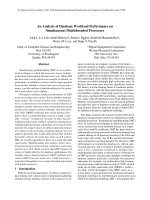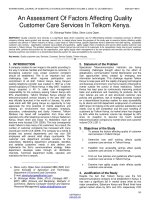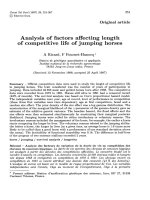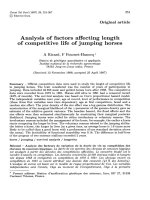An analysis of factors affecting decisions on investment in HCMC municipal bonds
Bạn đang xem bản rút gọn của tài liệu. Xem và tải ngay bản đầy đủ của tài liệu tại đây (569.92 KB, 16 trang )
An Analysis of Factors Affecting Decisions
JED No.219 January 2014| 93
An Analysis of Factors Affecting Decisions on
Investment in HCMC Municipal Bonds
Nguyễn Thị Mỹ Linh
Industrial University of Hochiminh City
Phùng Thị Cẩm Tú
Industrial University of Hochiminh City
Đào Thị Minh Huyền
University of Economics HCMC
ARTICLE INFO
Article history:
Received:
May 30, 2013
Received in revised form
Sep. 24, 2013
Accepted:
Dec. 31, 2013
Keywords:
bonds, municipal bonds,
affecting factors, investment
decisions.
Dương Thị Bình Minh
University of Economics HCMC
Vũ Thị Minh Hằng
University of Economics HCMC
Diệp Gia Luật
University of Economics HCMC
ABSTRACT
The paper analyzes factors affecting decisions on investment in
HCMC municipal bonds for infrastructure projects. Results of EFA
and regression analysis show that decisions on investment in HCMC
municipal bonds depend on five factors with adjusted R2 equaling
72,1%: (1) government’s policies; (2) bonds and issuers; (3)
infrastructure projects and socioeconomic conditions; (4)
economicfactors; and (5) impacts of relevant markets.
This serves as a basis for policy recommendations that aim at
enhancing the mobilizing power of municipal bonds for infrastructure
project in particular and socioeconomic development in HCMC in
general.
94 | Dương Thị Bình Minh et. al. | 93 - 108
1. INTRODUCTION
Investments in infrastructure projects play a crucial role in the local socioeconomic
development in particular and generate motivation for socioeconomic development in
general. The issue is that demand for capital is huge, calling for the mobilization of
various sources, among which issuing municipal bonds is one of the effective methods,
offering low-interest and long-term capital for infrastructure and other social welfare
projects.
However, although HCMC has been the first city to issue municipal bonds, this
source of capital reveals several limitations; for instance, municipal bond markets in
HCMC and other provinces or cities have not developed; issuers did not care about trade
in such bonds on the stock market; capital from the bonds is very small in comparison
with the demand for capital for infrastructure construction; and this commodity does not
attract the attention of investors.
To enhance the mobilizing power, therefore, the paper analyzes the factors affecting
decisions on investment in HCMC municipal bonds and provides policy
recommendations for effective mobilization of municipal bond capital for infrastructure
projects and socioeconomic development in HCMC.
2. RESEARCH DATA AND METHODOLOGY
a. Data:
The data was collected by distributing ready-designed questionnaires directly or
electronically to the respondents being managers, officials, and employees from
investment funds, banks, securities firms, etc. in HCMC [1]. The survey ran from
September to October 2012, coming up with a sample of 180 returned questionnaires
[2].
b. Methodology:
Various methods combined and employed in the study include survey, analysis,
synthesis, among which the principal one is factor analysis with a regression model and
the support of SPSS to assess the impact of the factors affecting decisions on municipal
bond investment.
3. THEORY OF MUNICIPAL BONDS AND FACTORS AFFECTING DECISIONS ON THE
BOND INVESTMENT
a. Theory of Municipal Bonds:
An Analysis of Factors Affecting Decisions
JED No.219 January 2014| 95
Bond is a kind of debt instrument on financial market, confirming the obligation of
the issuers to pay both principal and interest on a specified date. There are many different
classes of bonds on financial markets, including government bond, municipal bond and
corporate bond.
In Japan’s perspective, municipal bonds are issued by local government to cover part
of the cost, forming the debts tackled by the government and being purchased by private
financial institutions often with a maturity of over a year. [3]
In Vietnam, a municipal bond, aka “local bond,” is a type of bond issued by
provincial/municipal people’s committee according to annual plans of local budget or
finance income-generating works. [4]
In legal terms, municipal bonds are issued by provincial/municipal people’s
committee directly under central authority to raise fund for local investment projects. [5]
The two basic types of municipal bond on financial markets are general obligation
bond and revenue bond. The issuers are people’s committees of provinces and cities
directly responsible to the central government. They may have bonds issued by local
branches of National Treasury or other financial/ credit institutions to raise funds for
locally-financed works.
Methods of municipal bond issuance consist of bidding through the SBV and Stock
Exchange, underwriting, issuance through issuing agency or direct issuance through
National Treasury.
Regarding issuance mechanism, the basic criteria to be adhered to include the
following: legal basis of municipal bond issuance, types of issued bond, volume of
capital mobilized by bonds, principles and methods of issuance, credit rating, interest
rate, bond repayment when due, management of mobilized capital and purposes of
capital usage
b. Factors Affecting Decisions on Municipal Bond Investment:
Today, in the trend of international and regional economic integration, Vietnam has
gradually engaged in global business and investment. Accordingly, investment in
municipal bonds also follow market mechanisms and competitive bidding [6];
theoretical basis and results of qualitative research show that decisions on such
investment are governed by the following factors:
96 | Dương Thị Bình Minh et. al. | 93 - 108
- Legal and institutional factors: They include the stability of laws, relevant tax
policies and laws such as Investment Law, Companies Law, Labor Code, and Antitrust
Law, and other relevant policies. These factors have influenced all economic sectors in
a territory concerning their survival and growth.
- Economic factors: These factors have considerable effects on the economy, such as
interest rates, inflation, state of the economy, economic policies and future prospects
like growth rates, GDP growth, ratio of GDP to investment, etc. Enterprises should pay
attention to the economic factors in the short and long run and government intervention,
which usually serve as a basis for their investment decisions.
- Socio-cultural factors: Each country or region has its cultural values and specific
social factors, which feature characteristics of the consumers in that area. Besides
cultural traits , social aspects also attract attention among enterprises in market research
and business investment decisions.
- Technological factors: These voice concerns among business units when investment
decisions are made. Such concerns include public investment, technology replacement,
and impact of IT or Internet on business operations.
- Integration: In addition to these basic elements, current studies on the market also
notice the importance of globalization, a macroeconomic factor affecting all sectors.
4. RESEARCH MODEL
To analyze and identify the factors that influence decisions to invest in HCM
municipal bonds, authors conducted a survey to gather firsthand data and developed a 5level questionnaire (Likert scale). The initial model includes seven groups of factors
affecting the decisions. After a preliminary study to adjust the scale, the main research
and necessary tests were conducted. The research came up with only five groups of
factors affecting the decisions on HCM municipal bond investment: (1) laws and
policies, (2) bonds and issuers, (3) infrastructure development projects and
socioeconomic factors, (4) economic factors, and (5) impact of relevant markets.
Descriptive statistics illustrates that in the laws and policies group, the factors
“transparent management of infrastructure projects and capital from issued bonds” and
“legal framework for municipal bond market” are considered the most influential in the
decisions (3.21). In the bonds and issuers group, the factor “market price of bonds”
seems to have the greatest impact (2.92) along with other factors.
JED No.219 January 2014| 97
An Analysis of Factors Affecting Decisions
Table 1: Impact of Factors Affecting Decisions on HCM Municipal Bond
Investment
(1: no impact; 2: slight impact; 3: medium impact; 4: large impact; 5: very large impact)
Group of factors
A
Laws and policies
Level of impact
a1
Legal framework for municipal bond market
3.21
a2
3.11
b1
Incentive to investment and development of local
infrastructure
Transparent management of infrastructure projects
and capital from issued bonds
Market price of bonds
b2
Procedure for interest payment
2.81
b3
Bond-issuing procedure
2.42
b4
Risk-preventing measures for bond issuance
2.84
b5
Bond creditworthiness
2.90
c1
Project managing competence
3.31
c2
Socioeconomic effects of the projects
3.38
c3
Local population growth
3.02
c4
Improvement in welfare and living standard by the
infrastructure project
Possibility of promoting businesses
3.11
3.06
d1
Enhancement in terms of quantity and quality of
public services
Inflation rate
d2
Market interest rate
3.37
d3
Impact of capital flows in the economy
3.34
e1
Development of financial market in Vietnam
3.56
e2
Impact of stock market
3.49
e3
Impact of bond market
3.51
a3
B
C
Bonds and issuers
Infrastructure
development
projects
and
socioeconomic
factors
c5
c6
D
E
Economic factors
Impact of relevant
markets
Average
score
Source: Authors’ survey and calculations
3.21
2.92
3.26
3.83
98 | Dương Thị Bình Minh et. al. | 93 - 108
5. ANALYZING AND TESTING THE MODEL
a. Analysis of Factors Affecting Decisions on HCM Municipal Bond Investment:
- Group A - Laws and policies
System of laws and policies relating to municipal bonds regulate bond issuance,
issuers, classes of bonds, circulation of bonds, tax obligations, and rights and obligations
of the parties involved in bond transactions.
The legal system, accordingly, is a key factor directly affecting investment decisions.
However, in the past the system of laws and policies has not created favorable conditions
for the development of municipal bonds. In early 1994 HCMC People’s Committee
asked the Ministry of Finance to approve a pilot scheme to issue bonds to fund Nguyễn
Tất Thành Street Project for the first time. Total required investment for the project was
VND41.8 billion, 30 billion of which was from municipal bonds.
After Decree 93/2001/NĐ-CP dated Dec. 12, 2001 on delegation of managerial
authority in certain fields to HCMC government was issued, the city was allowed to raise
funds by issuing municipal bonds, and the plan was later established. However, it was
not until the promulgation of Decree 141/2003/NĐ-CP dated Nov. 20, 2003 and
modified, adjusted and substituted by Decree 01/2011/NĐ-CP dated Jan. 5, 2011 that
the issuance was really launched.
Following the plan, HCMC raised VND2,000 billion per year by means of bond
issuance in the period 2003 - 2007, mostly from financial institutions and commercial
banks. The year 2009 first recorded municipal bonds for income-generating public
works, particularly for the project of Thủ Thiêm New Urban Area with a plan to issue
VND4,000 billion worth of bonds, and in fact, underwriters raised VND1,540 billion.
The system of laws on bond issuance that was enacted, adjusted, modified, and improved
is a necessary condition and a legal corridor for effective and legal issuance that creates
faith for investors.
- Group B – Municipal bonds and issuers:
Municipal bond is a kind of debt instrument in financial markets, confirming the
obligation of the issuers to pay both principal and interest on a specified date. The two
basic types of municipal bond are general obligation bond and revenue bond, the interest
rate of which is decided by issuers for each series of issuance. The period 2003 – 2007
marked the issuance of the former, which was also issued in 2009 for income-generating
works included in the Thủ Thiêm New Urban Area Project.
JED No.219 January 2014| 99
An Analysis of Factors Affecting Decisions
The issuer was HCM People’s Committee, authorizing the Investment Fund for
Urban Development to issue the bonds. Sources of capital used for principal and interest
payments of general obligation bond come from the city’s budget. Due to the
characteristics and financial resources to ensure its solvency, HCM municipal bonds,
compared to other types of bonds in the market, gain a high creditworthiness. However,
bond purchasers, besides interest rate and market price, are particularly interested in
issuers and their ability to maintain budget balance and repay bond principal and interest.
Table 2: Issuance of HCM Municipal Bonds (VND billion)
2-year term
3-year term
5-year term
10-year term
15-year term
Year
Value Interest rate
2003
200
Value
Interest rate
8.52%
Value
1,800
Interest rate
Value
Interest rate
Value
Interest rate
9%
Total
value
2,000
8.5%
1,600
2004
400
9%
2,000
-8.7%
9%
1,035
2005
965
9.55%
2,000
-9.05%
8.8%
850
2006
9.15%
525
-9.05%
756
2007
8.50%
9.25%
625
-9.25%
742
2,000
-9.55%
502
2,000
2008
1,540
2009
Total
200
10 %
1,540
1,540
6,041
1,667
2,092
11,540
Source: HCMC Department of Finance
- Group C – Infrastructure development project and socioeconomic factors
Investing in municipal bonds, investors not only gain some interest payments but also
support development of infrastructure, which leads to improvements in welfare and
living standards and further development of local economy. Over the past ten years,
funds raised from municipal bonds were invested in: (1) Projects belonging to HCMC
key programs, (2) Projects to improve the HCMC local grid, (3) Construction of
industrial parks/clusters in HCMC, (4) Project on compensation, site clearance,
construction of residential resettlement quarters, and (5) Other projects with loans
approved by HCMC People’s Committee on a case-by-case basis.
Municipal bond investors also examine project management to ensure it would be
right on schedule and of high quality, and they want the projects to be socioeconomically
100 | Dương Thị Bình Minh et. al. | 93 - 108
efficient. Particularly infrastructure to be built should match urban, educational, and
healthcare facilities, etc., to improve the quality of public services.
- Group D - Economic factors
Economic development and ability to attract capital flows will affect competitiveness
as well as decisions on the investment portfolio made by investors. In contrast, inflation
or increases in market interest rates will be a serious obstacle to the bond issuers. In other
words, bond investors will demand a higher rate of return or higher bond interest rates.
In the period 2006 – 2007 or 2009 for example, when financial market was heating
up and investment in stocks brought attractive profits as well as high liquidity, investors
showed less interest in bonds. Effects of economic crisis and recession, and high
inflation rates without flexible and prompt adjustment to interest rates produced very
bad impacts on the HCMC bond issuance in 2009.
- Group E – Impact of Relevant Markets
Liquidity of the bonds depends primarily on the development of financial markets,
which, once developed, will create more commodities deemed competitive against
municipal bonds. Thus, investors always show concerns with the liquidity and
profitability of bonds versus those of other financial assets.
Over the courses of bond issuance in HCMC, the fact that stock market underwent
volatility in 2003 also affected the bond market in 2004 and 2005. Since 2006 and 2007,
the warming of the stock market has completely overwhelmed the bond market in
general and municipal bond market in particular, which made investors stop caring about
bonds with low and fixed profitability, while the reverse case rings true for investment
in stocks. In 2003 bond purchasers came from all walks of life, and yet from 2004
onward those have been recorded mainly as commercial banks, insurance companies,
and securities firms, etc., and issuance method would mainly be underwriting; investors
made bond purchase, holding on to the bonds until their maturity.
b. Model Testing:
Multiple regression model is used to estimate the factors affecting decisions on
HCMC municipal bond investment with the general form as follows:
F = β0 + β1 A + β2 B +β3 C + β4D + β5E
where:
Dependent variable F: Level of decisions on the bond investment
JED No.219 January 2014| 101
An Analysis of Factors Affecting Decisions
Independent variables: A: Factor group of laws and policies, B: Factor group of
municipal bonds and issuers, C: Factor group of infrastructure development projects and
socioeconomic factors, D: Economic factors, and E: Impacts of relevant markets.
β0 : level of impact of other factors apart from the main factors in the model
β1, β2, β3, β4, β5,: regression coefficients indicating the importance level of the factors
affecting decisions on HCMC municipal bond investment
Hypotheses H0: β1 = β2 = β3 = β4 = β5 = 0 (inappropriate model)
H1: there exists at least a βi different from 0 [ i = 1 5] (appropriate model)
Testing the model:
- Determining the Cronbach’s Alpha
Cronbach’s Alpha is used to find significant variables for inclusion in factor analysis,
and results are as follows:
Table 3: Determination of Cronbach’s Alpha
Factor
Cronbach's Alpha
Variables observed
Group A
0.623
3
Group B
0.933
5
Group C
0.924
6
Group D
0.635
3
Group E
0.956
3
F (dependent variable)
0.609
3
Source: Authors’ calculations
The results show that the variables in each factor group are correlated with one
another since Cronbach's Alpha of each reaches a significance level greater than 0.6.
- EFA
Variables with satisfactory Cronbach’s Alpha were included in EFA to assess
convergence of the observed variables to select the significant factors for regression
analysis. The KMO index is used to measure the sampling adequacy, a KMO value
varying between 0.5 and 1 is a sufficient condition for a good factor analysis.
102 | Dương Thị Bình Minh et. al. | 93 - 108
Table 4: KMO and Bartlett's Test
KMO value
0.687
Bartlett's test
Chi square estimation
3,565.346
Df
190
Sig.
0.000
Source: Authors’ calculations
Table 5: Rotated Component Matrix
Component
1
c5
0.907
c1
0.851
c3
0.839
c6
0.786
c2
0.768
c4
0.711
2
b2
0.920
b4
0.901
b5
0.883
b1
0.866
b3
0.752
3
e1
0.946
e3
0.936
e2
0.894
4
a2
0.714
a3
0.709
a1
0.561
d3
5
0.804
JED No.219 January 2014| 103
An Analysis of Factors Affecting Decisions
d2
0.786
d1
0.651
Source: Authors’ calculations
With a KMO value of 0.687 and Sig. 0.000, implying the model achieves a
convergent value; all variables have factor loadings larger than 0.5. EFA comes up with
5 components being independent variables, which are included in the multiple regression
model for the model testing.
- Final test of the research model
The test is undertaken with Enter method in which F (group F) is a dependent variable
whereas A, B, C, D, and E (group A, B, C, D, and Erespectively) are independent
variables. The results show that R2 is 0.721, ANOVA (F test) has Sig. <0.05; thus,
independent variables are linearly correlated with dependent variables; the regression
coefficient results are as follows:
Table 6: Summary of Regression Results
Variable
Unstandardized Coefficient
(B)
Standardized Coefficient
(Beta)
(constant)
8.472E-17
C
0.131
0.131
0.001
B
0.336
0.336
0.000
E
0.156
0.156
0.000
A
0.744
0.744
0.000
D
0.144
0.144
0.000
Sig.
1.000
Note: D, A, E, B, C: independent variable & F: dependent variable
The results show that all coefficients obtain Sig. ≤ 0.05, proving that the independent
variables included in the model have explanatory power; therefore, H1 is accepted and
H0 is rejected. In addition, to assess the adequacy of the model, the coefficient R2 or
adjusted R2 is employed, indicating the fitness of the regression model based on the
research data sets.
104 | Dương Thị Bình Minh et. al. | 93 - 108
The adjusted R2 = 0.721, implying 72.1% of the variation of investing entities would
be explained by independent variables selected in the model. Therefore, it could be
concluded that the model is suitable, and the regression function is:
F = 0,744A + 0,336 B + 0,131 C + 0,144 D + 0,156 E
6. CONCLUSIONS
The regression results reveal that decisions on municipal bond investment have
positive relationship with the factors, and their effects are arranged in order of reducing
importance: Factor group of laws and policies (group A); factor group of municipal
bonds and issuers (group B); impacts of relevant markets (group E); economic factors
(group D); and factor group of infrastructure development projects and socioeconomic
factors (group C).
Table 7: Importance Order of the Factors
Independent Variable
Absolute Value
Percentage
A
0.744
49.2%
B
0.336
22.2%
E
0.156
10.3%
D
0.144
9.5%
C
0.131
8.7%
Total
1.510
100%
Thus, to attract more investors to the municipal bond market to effectively facilitate
its development and mobilize financial resources for HCMC infrastructure projects, the
most urgent task is to improve laws and policies and create safe legal corridor for entities
involved in the market. Next, there should be policies to encourage more commodities
for the bond market and enhance of issuers’ capability and creditworthiness.
Furthermore, the development of relevant markets, steady economic growth and other
factors related to the development of infrastructure or socioeconomic factors could foster
the development of this market.
7. POLICY RECOMMENDATIONS
In order to maximize the mobilization of financial resources through HCM municipal
bonds for infrastructure development, some policy recommendations are to be offered,
An Analysis of Factors Affecting Decisions
JED No.219 January 2014| 105
focusing on two most influential groups: (1) Factor group of laws and policies; and (2)
Factor group of municipal bonds and issuers.
a. Factor Group of Laws and Policies:
First, legal provisions should be completed specifically for municipal bond market.
This is to promote the market development but still ensure the managerial role of the
government and the rights of the participants for the sake of a legal environment in
accordance with requirements from the market. The development of legal framework
should well adapt to the following principles:
- It ensures an efficient operation of medium- and long-term capital market and
centralized and unified management for issuers’ and investors’ interest, thereby making
municipal bonds more attractive to investors.
- It should develop the municipal bond market according to national economic
development goals in different phases and complying with all policies and guidelines
put forward by the government.
Second, a specific decree on issuance regulations should be issued to guide the listing
and transaction of the bonds on the stock market.
Third, legal documents on local debt management should be compliant with public
debt management and national budget laws.
- At present, the Public Debt Law, due to a lack of its complete model in a national
scale, have yet to specify the debt threshold but only establish a coefficient system to
compare and evaluate the volatility of the national debt during the process of securing
and employing loans. Moreover, it only stipulates that lawful sources of finance could
be used to cover deficit but fails to introduce schemes of repaying public debts and
specify what sources of finance are lawful.
- Establishment of a debt threshold could help manage the public debt at provincial
level, thereby ensuring healthy financial basis and rational structure of public debts for
each stage of development. At present, the public debt owed by provincial governments
is still low and comes from loans or financial support from central agencies. Securing
loans by issuing local bonds requires a mechanism for controlling public debt at
provincial level to ensure a balanced local budget repayment of public debts.
Fourth, official guidelines on bond and derivatives repo on municipal bond market
should be issued to help boost transactions in this market.
106 | Dương Thị Bình Minh et. al. | 93 - 108
b. Factor Group of Municipal Bonds and Issuers:
First, commodities for municipal bond market should be diversified.
Bonds to be issued should offer various maturities, interest rates and term of
repayment to meet different demands by investors and financial market.
Second, encouragement to investors in municipal bond market is another concern.
Attracting commercial banks, insurance funds as investors along with foreign
investing institutions to the municipal bond market could be done by building
transparent information system and publicizing issuance plans at the beginning or end
of each year. The use of mobilized funds and process of disbursement should also be
officially and publicly announced for trust creation among investors.
Third, the development of bond market could be based on linkages between primary
market and secondary one. A standard interest rate curve used as a reference could be
developed to facilitate issuance, transactions, and investment in the bond market.
Fourth, as for methods of payment, the issuers are responsible for organizing an agent
network corresponding to issuing agents to ensure convenience in bond payments. The
Department of Finance, when the maturity date approaches, should transfer funds to
issuers or settlement agents who pay principal and interest to bondholders.
Since municipal bonds are listed and traded, bond interest and principal payments
should be uniformly made through such agency as Depository Center, which reduces the
cost born by both issuers and investors. Regarding the payment method, the center
should transfer the payments to individual account at the request of the bondholders.
Fifth, developing prospectuses for the issuance plans.
A prospectus that serves as an invitation or offer based on which investors purchase
bonds or stocks from issuers should include all information related to the issues;
therefore, the information provided in the prospectus should be associated with the
provisions of invitation or offer implementation. In particular, information about
socioeconomic and/or financial situations in the past and forecasting future financial
prospects, possible sources of budget income needed for annual repayments of bond
should also be transparent, fully informed, and clear.
Sixth, credit rating of municipal bonds needs conducting.
Cooperating with and learning from international credit rating organizations to
develop a mechanism for rating government and municipal bonds are very needed. For
An Analysis of Factors Affecting Decisions
JED No.219 January 2014| 107
the time being when credit rating has yet to be applicable, there should be other available
measures to determine bond creditworthiness, which, in fact, are considered as
temporary ones and merely applied for general obligation.
In the long term, to expand this channel, the bond issuing process should be improved
and carried out according to international practices, and issuers ought to be rated by
credit rating organizations. The credit rating may help issuers to make the best use of
their competitive advantages over their rivals in other provinces or cities to attract local
and foreign investors, thereby ensuring successful issuance of bonds at low costs. The
credit ratings would accordingly function as another important information channel that
ensures objectivity, transparency and credibility of bond investment. This task is more
urgent when more and more foreign investors are interested in Vietnamese market after
its financial market is liberalized and internationalized.
Seventh, issuers need determine the target debt portfolio, long-term costs and
expected risks; organize market for bond listing and transaction; and replace nonperiodic issuance with periodic one with relevant information widely publicized
Notes:
[1] Selected respondents are working in finance and bond trade sectors.
[2] According to an article on the Journal of Finance Research, the optimum number of samples and
variables for the regression function is n ≥ 30 + p if the respondents are enterprises and n ≥ p x 10
as for individual respondents (n: the number of samples; p: number of independent variables, p <
20). Moreover, Hoàng Trọng & Chu Nguyễn Mộng Ngọc in their Phân tích dữ liệu nghiên cứu
với SPSS (2008, Vol 2, p. 31) suggest that the number of samples are at least four or five times as
many as that of observed variables in factor analysis. In this research, 180 samples chosen as
representatives of the population are considered adequate for the analysis, establishment and
construction of regression function.
[3] Tanaka,Y. (2011)
[4] HFIC: HCMC Investment Fund for Urban Development is authorized by HCM People’s
Committee to perform all operations in municipal bond issuance as regulated.
[5] According to Clause 3, Article 2, Chapter 1 of Decree No. 01/2011/NĐ-CP dated Jan. 5, 2011.
[6] Pursuant to Decree No. 01/2011/NĐ-CP dated Jan. 5, 2011.
108 | Dương Thị Bình Minh et. al. | 93 - 108
References
Đinh Thế Hiển (2002), “Một số giải pháp trong việc sử dụng trái phiếu đô thị ở thành phố Hồ Chí
Minh”, paper presented at workshop “Trái phiếu đô thị ở Việt Nam: Triển vọng và phương thức
phát hành”.
Harwood, A. (2000), Building Local Bond Markets: An Asian Perspective, Word Bank Publications.
HCMC People’s Committee (2012), “Quy hoạch tổng thể phát triển kinh tế - xã hội TP.HCM đến
năm 2020, tầm nhìn đến năm 2025”.
Leigland, J. (1997), “Accelerating Municipal Bond Market Development in Emerging Economies:
An Assessment of Strategies and Progress”,Public Budgeting & Finance, Vol.17(2), pp.57-80.
Nguyễn Đình Tài & Lê Thanh Tú (2010), “Nâng cao hiệu quả đầu tư công ở VN”, Tài chính (April
2010), pp.21-24.
Nguyễn Ngọc Thanh & Trần Mạnh Kiên (2002), “Một số chính sách thúc đẩy thị trường trái phiếu
đô thị ở Việt Nam”, paper presented at workshop “Trái phiếu đô thị ở Việt Nam: Triển vọng và
phương thức phát hành”.
Peterson, G. (2000), Building Local Credit Systems, The World Bank.
Peterson, G. (2002), Bank or Bond: Building a Municipal Credit Market, The Urban Institute,
Washington D.C.
Phạm Phan Dũng (2002), “Triển vọng phát triển trái phiếu đô thị ở Việt Nam”, paper presented at
workshop “Trái phiếu đô thị ở Việt Nam: Triển vọng và phương thức phát hành”.
Porter, M. (1998), Competitive Strategy – Techniques for Analyzing Industries and Competitors, The
Free Press, New York, USA.
Trần Đắc Sinh (2002), Định mức tín nhiệm tại Việt Nam, Thành phố Hồ Chí Minh Publisher.
Trần Đắc Sinh (2004), Huy động vốn đầu tư cơ sở hạ tầng qua thị trường chứng khoán, Thành phố
Hồ Chí Minh Publisher.
Steiss, A.W. (1975), Local Government Finance: Capital Facilities Planning and Debt
Administration, Lexington Books.
Tanaka,Y. (2011), Local Bonds in Japan, Institute for Comparative Studies in Local Governance
(COSLOG), Kagawa University.









